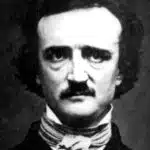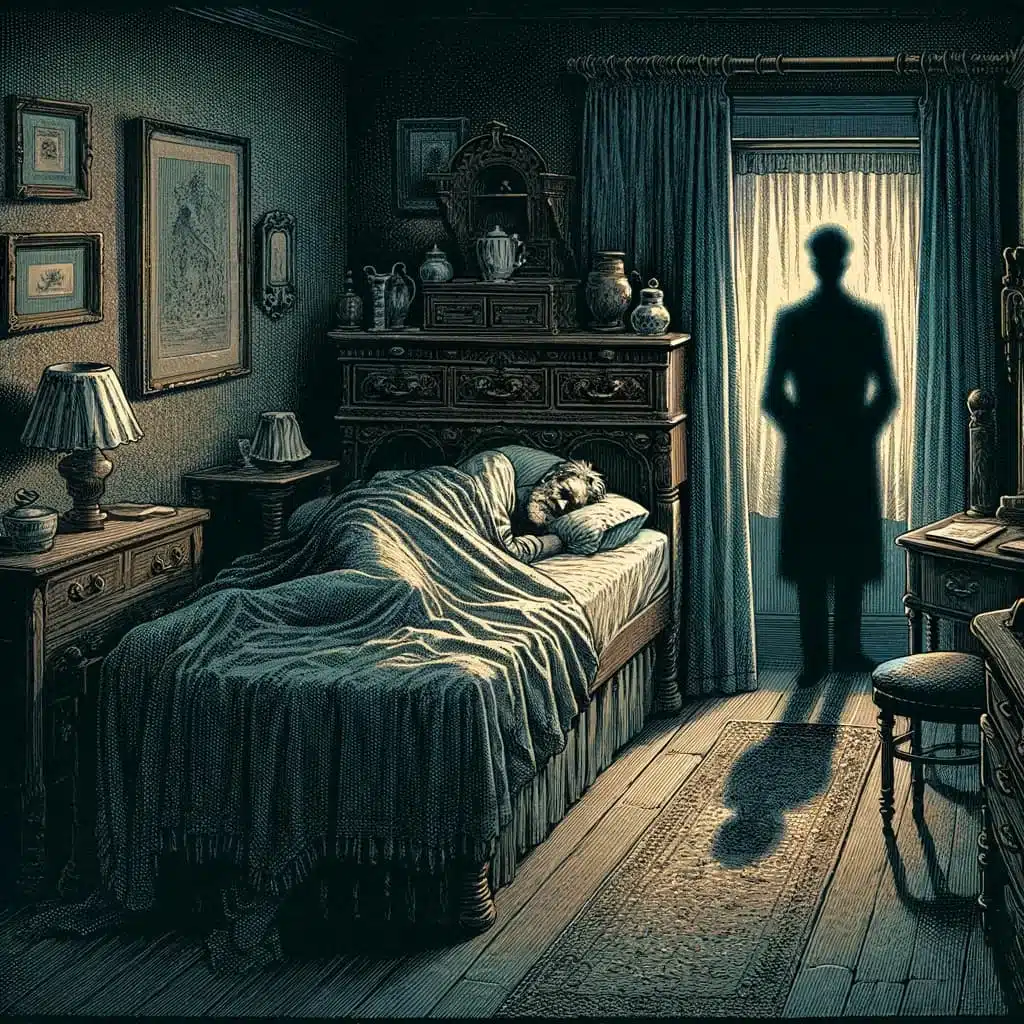56 The Tell-Tale Heart Essay Topics & Examples
Looking for The Tell-Tale Heart essay topics? The short story by Edgar Allan Poe, a recognized master of horror fiction, is definitely worth analyzing!

🖤 The Tell-Tale Heart Essay Prompts
❓ the tell-tale heart essay questions, 🏆 best the tell tale heart topic ideas & essay examples, 📌 the tell-tale heart essay topics, 👍 the tell-tale heart essay examples.
In your The Tell-Tale Heart essay, you might want to write about the story’s characters, themes, or symbols. Anyway, our article will be helpful. Find here all you might need to write a paper on Poe’s short story! The Tell-Tale Heart essay examples, prompts, questions, and topic ideas.
The Tell-Tale Heart Point of View Analysis
Poe wrote the novel from the first-person point of view. The protagonist tells the story of a murder while stating that his senses were destroyed by “the disease” but he’s still sane. Think why this might be important. Is the mad person’s narration reliable?
How different would be the story if it were told by the old man or police officers?
Symbols in The Tell-Tale Heart
If you’re writing The Tell-Tale Heart symbolism essay, you may choose one or few symbols in the story:
- The old man’s eye. Analyze why the eye catches the attention of the killer. The narrator calls it the “vulture eye” and “evil. In your essay you can explain why the narrator does not dare to kill the old man when his eye was closed, and the crime was committed only when he saw the open eye.
- The old man’s heart. The heart in the novel symbolizes the killer’s conscience and his humanity as he finally confesses. Analyze why the narrator hears the heartbeat twice.
Another point to consider in your The Tell-Tale Heart essay is the analysis of the connection between time and heart. Time is compressed and stretched.
It pulses as the heart. But time also symbolizes death and the killer acts as part of a watch. Thus, the heart in the novel symbolizes life, and, through time, it turns out to be a symbol of death.
The Tell-Tale Heart Literary Analysis
Typical academic articles are hard to read because of complex words and compound sentences. When you read Poe’s masterpieces, you read them quickly because the author writes in short sentences.
Poe uses many figures of speech like similes, personification, anaphora, and irony. Analyze how these figures help Poe to convey the main idea to the reader.
The Tell-Tale Heart Characters
There are four characters you might want to explore in your character analysis: the narrator, police officers, the old man, and the neighbor.
All of them play an important role in the plot. For example, the narrator is mentally ill person who doesn’t make a difference between the “unreal” and “real”. There are also a few signs that he rarely sleeps. You can analyze how his insomnia might impacted his actions and desire to kill.
- What is the theme of The Tell-Tale Heart ?
- What is the mood of The Tell-Tale Heart ?
- What genre is The Tell-Tale Heart ?
- What is the conflict in The Tell-Tale Heart ?
- What does the heart symbolize in The Tell-Tale Heart ?
- What is the tone of The Tell-Tale Heart ?
- What is the central idea of The Tell-Tale Heart ?
- What point of view is The Tell-Tale Heart ?
If you’re looking for The Tell-Tale Heart essay topics or ideas to add to it, check IvyPanda’s free samples of high-quality papers!
- The Tell-Tale Heart Psychological Analysis & Critique The outstanding character in the tale, who is also the narrator, attracts a lot of attention from the readers. The narrator forms the basis of the tale.
- Edger Allen Poe’s “The Tell-Tale Heart” Analysis The narrator in the beginning of the story clearly states that he is not insane but his actions make the reader frown at his sanity.
- The Tell-Tale Heart by Edgar Poe This metaphor is necessary to show that the feeling of guilt distorts his perception of reality. This is one of the details that can be distinguished.
- The Investigation of Ethical Issues in The Tell-Tale Heart and The Pond The secondary problem is related to an ethical dilemma with regards to the responsibility of the husband to provide and care for the family.
- Gothic Romanticism in Edgar Allan Poe’s “The Tell-Tale Heart”, Nathaniel Hawthorn’s “The Birthmark” In the film “The Black Swan” directed by Darren Aronofsky, Nina struggles to fit into the ultimate role of the play “The Swan Lake”, as the Black Swan, even though she is comfortable playing the […]
- The Tell-Tale Heart (1843) This section tackles the main characters of the story and as aforementioned, the narrator and the old man are the only central characters in the story.
- The Tell-Tale Heart Essay However, when the police came to the Old Man’s house he gives himself away to the police because he hears the heart of the old man beating behind the floorboard and this incident may suggest […]
- The Murderer’s Motivation Depicted in Poe’s “The Tell-Tale Heart”
- The Characters of Nervousness in “The Tell-Tale Heart” by Edgar Allan Poe
- Morality in Edgar Allan Poe’s “The Tell-Tale Heart”
- Paranoia in Prose and an Analytical Treatment of Edgar Allan Poe’s “The Tell-Tale Heart”
- Stylistic Analysis of “The Tell-Tale Heart” by Edgar Allan Poe
- Sanity of the Narrator in “The Tell-Tale Heart” by Edgar Allan Poe
- Poe’s Use of the Senses in “The Cask of Amontillado” and “The Tell-Tale Heart”
- The Role of the Gaze in Poe’s “The Tell-Tale Heart”
- An Analysis of the Creating of an Atmosphere of Horror and Build Tension in “The Tell-Tale Heart” by Edgar Allan Poe
- Writing Styles in “The Tell-Tale Heart” by Edgary Allen Poe
- Stability of Characters in “To Build a Fire” and “The Tell-Tale Heart”
- Styles of “An Occurrence at Owl Creek Bridge” Versus “The Tell-Tale Heart”
- Feeling of Madness Throughout “The Tell-Tale Heart” by Edgary Allen Poe
- The Inspiration From the Authors’ Lives in “The Tell-Tale Heart” and “The Cask of Amontillado” by Edgar Allan Poe
- Inescapable Truth: An Analysis of “The Tell-Tale Heart”
- Rationalization and Suspense in Poe’s “The Raven” and “The Tell-Tale Heart”
- Identity as an Important Part of “The Tell-Tale Heart”
- Analysis of Symbolism in Edgar Allan Poe’s “The Fall of the House of Usher” and “The Tell-Tale Heart”
- “The Tell-Tale Heart” Character Analysis of Main Character
- The Importance of Suspense in “The Tell-Tale Heart” by Edgar Allan Poe
- Horror and Figurative Language in “The Tell-Tale Heart”
- Imagery Through the Eye of “The Tell-Tale Heart”
- The Attempt to Prove a Man’s Sanity in “The Tell-Tale Heart” by Edgar Allan Poe
- Psychosis and Guilt in “The Tell-Tale Heart”
- Literary Elements of Edgar Allan Poe’s “The Tell-Tale Heart”
- Philosophy of Composition in the “Tell-Tale Heart”
- The Reflection of the Soul in Edgar Allan Poe’s “Tell-Tale Heart”
- Role of Realism in Edagar Allan Poe’s “The Tell-Tale Heart”
- Mental Challenges in “The Tell-Tale Heart”
- The Themes of Surveillance and Control in “Discipline and Punish” by Michael Foucault and “The Tell-Tale Heart” by Edgar Allan Poe
- The Narrator’s Story in “The Tell-Tale Heart” by Edgar Allan Poe
- Similarities Between Edgar Allan Poe and “The Tell-Tale Heart”
- Edgar Allan Poe’s “The Tell-Tale Heart” as a Gothic Horror
- Techniques Used in Writing “The Tell-Tale Heart” and “The Red Room”
- Understanding Poe’s “The Tell-Tale Heart”: Insanity or a Stroke of Brilliance
- Mind Games and the Narrator Madness in “The Tell-Tale Heart”
- A Comparison of “The Tell-Tale Heart” by Edgar Allan Poe and the Work of Raymond Carver
- Misperceptions and “The Tell-Tale Heart” by Edgar Allan Poe
- “The Cast of Amontillado” vs. “The Tell-Tale Heart” by Edgar Alan Poe
- Morality in “Young Goodman Brown” by Hawthorne and “The Tell-Tale Heart”
- Internal Conflict in “The Tell-Tale Heart” by Edgar Allan Poe
- Chicago (A-D)
- Chicago (N-B)
IvyPanda. (2023, December 13). 56 The Tell-Tale Heart Essay Topics & Examples. https://ivypanda.com/essays/topic/the-tell-tale-heart-essay-examples/
"56 The Tell-Tale Heart Essay Topics & Examples." IvyPanda , 13 Dec. 2023, ivypanda.com/essays/topic/the-tell-tale-heart-essay-examples/.
IvyPanda . (2023) '56 The Tell-Tale Heart Essay Topics & Examples'. 13 December.
IvyPanda . 2023. "56 The Tell-Tale Heart Essay Topics & Examples." December 13, 2023. https://ivypanda.com/essays/topic/the-tell-tale-heart-essay-examples/.
1. IvyPanda . "56 The Tell-Tale Heart Essay Topics & Examples." December 13, 2023. https://ivypanda.com/essays/topic/the-tell-tale-heart-essay-examples/.
Bibliography
IvyPanda . "56 The Tell-Tale Heart Essay Topics & Examples." December 13, 2023. https://ivypanda.com/essays/topic/the-tell-tale-heart-essay-examples/.
- The Raven Essay Titles
- The Fall of the House of Usher Research Ideas
- The Cask of Amontillado Research Ideas
- Hills Like White Elephants Essay Ideas
- The Handmaid’s Tale Research Ideas
- The Glass Menagerie Paper Topics
- I Know Why the Caged Bird Sings Research Ideas
- The Great Gatsby Ideas
- Lord of the Flies Research Ideas
- Letter From Birmingham Jail Titles
- The House on Mango Street Research Topics
- Scarlet Letter Research Ideas
- The Gift of the Magi Ideas
- Sir Gawain and the Green Knight Research Topics
- Sinners in the Hands of an Angry God Research Topics

Poe's Stories
Edgar allan poe, ask litcharts ai: the answer to your questions.
(92) 336 3216666
- The Tell Tale Heart
Background of the Story
“The Tell-Tale Heart” is a story by Edgar Allan Poe written in 1843. It is about a murderer who tries to persuade his readers of his mental stability while telling the tale of the brutish act. He denies that he suffers from some mental illness and openly boasts of his cleverness and cunning behavior. He kills an old man though he loves him. He holds no grudges against him and murders him without any motive.
The old man’s “vulture-eye” makes the narrator angry and he decides to kill him. He attends to every minute detail in the process of murder; carefully kills him, disjoints every part of his body, and then buries the body parts underground in the room. He also receives the policemen with utmost comfort but, slowly and gradually, his anxiety increases. His guilty conscience constantly pricks him and reminds him of his brutal act. Eventually, he cannot bear the secret anymore and confesses his crime to the policemen.
The untrustworthy narrator does not have a solid reason to murder the old man (apart from his hatred for the old man’s eye). Furthermore, Poe has not given us detail about the narrator’s relationship with the old man. We do not know, as readers, whether the narrator is a male or a female. Poe only focuses on the events and situations which lead to the killing rather than focusing on individuals.
The story is one of the classics of Poe’s short stories and of its genre. The setting and diction used in the story make it a classic Poe story. The story is a proof of human being’s inherently evil nature. The unreliable narrator in the story brutally murders the old man irrationally and without any reason. The story also explores the paranoiac state of mind of the narrator.
The Tell Tale Heart Summary
At the start of the story, the narrator is answering an imaginary listener. He confesses that he has been ill but denies the fact that he is insane. Furthermore, he announces that the illness has given him more strength especially to his “sense of hearing”. He tells the imaginary listener that he is more vigilant now and is able to hear everything. Then he tells the listener to listen carefully as he narrates the story.
He confesses that there was no motive for what he did. He loved the old man who never harmed him. The motive behind the murder was not his wealth and gold, however, one of his eyes made him kill the old man. He hated his vulture-like eye and it persuaded him to murder the old man. The narrator says that the old man’s eye angered him so he made up his mind to kill him to shut that eye once and for all.
Again he tries to prove his sanity by admitting that he planned carefully to murder the old man making us aware that an insane person cannot plan. He informs his readers that for seven continuous nights he would go into the old man’s room, quietly, and would wait for the exact moment to commit the crime. He would examine the old man’s eye with the help of his lantern and would find it close. He would return annoyingly as it is his “Evil Eye” which motivates him to murder him. Ironically, in the morning he would ask the old man how he spent the night.
He continues with the story and tells us that on the night of the murder he went to the old man’s room with more caution. He wonders at his cunning plan and laughs at the old man’s lack of awareness. Out of nowhere, the old man sensed something and moved. The narrator tells us that he did not feel afraid as he knew the old man could not see him in the darkness. He, quietly, entered the room. The old man suspected something and asked who was in the room.
The narrator informs us that he did not move an inch for an hour knowing that the old man is alert. Then he hears a frightening cry from the old man sitting alert in his bed. He tells us that the old man knows not of his presence but he can assume his death impending upon him. Afterwards, he gradually puts light on the old man and realizes that his hateful eye is open. It makes him angry. He does not notice his face because he is not interested in it rather it is his eye that troubles him. The sight of his eye fills him with rage.
Furthermore, as he boasts of his increased hearing sense, he hears the beating of the victim’s heart. He tries to stay calm but the beating of the old man’s heart increases his anger. The narrator becomes anxious and is unable to bear his heartbeat anymore. The narrator takes the help of the bedsheets and holds it firmly “over his head”. The old man, slowly and gradually, suffocates and his heartbeat stops. The narrator takes a sigh of relief knowing that his eye will never trouble him again.
He again challenges those who question his sanity and tells them that they should consider how he hid the dead body so as no one can find it. He disjoints every part of the dead body carefully. Then he removes the planks and hides the pieces there cautiously making sure nothing is left behind. Afterwards, he puts the planks down again, with great care, so that no one can get a clue of their removal.
When he finishes, the clock strikes four in the morning. Someone knocks at the door. He calmly opens the door and realizes that three policemen have arrived. They have been called upon by one of the neighbors who heard the shriek of the old man. They are here to investigate any mishap. He receives them calmly and tells them that he shrieked because of a nightmare. He escorts them all over the house and tells them to do their search. He even leads them to the old man’s room and offers them chairs to sit there and rest.
He confesses that his calm demeanor made the cops believe his explanation and they sat calmly there. They chat continuously and after a while, the narrator wishes they should depart. Slowly and gradually, he becomes anxious and his calmness fades away. In the meantime, he hears some sound. At first, he perceives it to be inside his head but then he realizes that the sound is not internal rather it is in the room. He talks louder and causes commotion in the room to cover it up but it gets louder with the passage of time.
He walks to and fro in the room to make some noise but its intensity increases. However, the policemen seem not to hear it and they are busy chatting and smiling as usual. The narrator thinks the policemen know and they are laughing at his stupidity. He says he constantly suffered because of their smiles and hearing that sound. Eventually, he cannot stand it anymore and confesses his crime. He tells the policemen to uncover the planks and they will find the mutilated body of the old man and his pumping heart.
Mental Health
Poe’s story shows its readers the importance of mental health. The story demonstrates that mental illness can drive a person to the vilest acts. Psychological problems can lead individuals to act dangerously without any motive. The narrator, in the story, suffers from some mental problems which lead to his destruction.
He, time and again, denies the fact that he suffers from mental illness but his awkward actions prove that he suffers from some psychological problem. He is obsessed with killing the old man for no apparent reason and scrutinizes him for seven successive nights. The narrator, being paranoiac, kills the old man out of fear but that is not an acceptable reason.
Furthermore, he also enjoys the moment when he suffocates the old man, holding the bed sheets tightly over his face. This event makes him a sadist; who enjoys inflicting pain on others. This event also shows that he has some psychological problems. Through these events, Poe demonstrates the idea that an individual’s psychological health is as important as his physical health.
Guilt is another significant theme in the story. Although the narrator does not feel guilty of his crime openly, however, it is his guilty conscience which leads him to confess his crime. At first, he murders the old man in his room and calmly hides his dead body underground. Then he calmly receives the policemen and leads them across the house. However, in the hearts of his heart, he feels nervous with the passage of time.
Slowly and gradually, he hears sounds which he did not hear previously. He becomes anxious and tries to evade the sounds by making a commotion. However, his guilt does not leave him until he confesses his crime. He is of the opinion that the heartbeat is that of the old man’s heart but actually it is his own heart pumping with guilt. Externally, he enjoys killing the old man but his guilty conscience does not let him enjoy the brutal act.
Confinement
The theme of confinement is central to the story. The actions in the story are confined to a house only. Neither the narrator nor the old man go outside the house throughout the story. The narrator wants to break this confinement by murdering the old man but is unsuccessful. He murders the old man but never breaks his confinement.
The narrator thinks he will escape the life of confinement by killing the old man who is a threat to his freedom, according to him, but never succeeds. Instead, after killing he becomes more confined to the old man’s room. First, he would roam around the house but after killing him, he sits with the policemen in the old man’s room. He does not leave the room until he confesses his crime.
This confinement can imply that the narrator’s own psych has imprisoned him and he is unable to escape it. He thought he would gain freedom by killing the old man unaware of the fact that it is his mental confinement rather than his physical which never lets him free.
Characters Analysis
Characters are people who have some individual traits in a piece of writing. Without characters, a piece of literature looks dull. They are mouthpieces for a writer through which a writer expresses their opinions about a particular issue. Characters provide them with an outlet to contribute to the social structure. Some characters are major characters on which the writer focuses more while others are minor characters who have a supporting role in a piece of writing.
Poe’s story revolves around the unreliable narrator who murders an old man for no apparent reason. Other characters in the story are not significant. The detailed analysis of his character is given below;
The Narrator
Poe does not give us information about the narrator’s gender. We, as readers, do not know whether he is a male or a female. We assume that he is a male and that is why we use the pronoun “He” for the narrator. After reading the story we conclude that he has many problems in his character; he suffers from paranoia, he is nervous and has some physical as well as mental illness. He tries to prove his sanity for the most part of the story.
After reading the story, we assume that the narrator acts according to his natural impulses. The narrator murders the old man because he thinks the old man is a threat to his individual freedom. Being paranoiac, the narrator assumes the old man is always trying to harm him, although he confesses that he has never harmed him, he acts in advance and takes his life. He murders the old man due to his own fear.
Furthermore, the narrator suffers from some kind of physical instability. His ears are hypersensitive and he hears sounds which others do not hear. We, as readers, do not know about his past and cannot claim that he suffers from some ailment but his awkward behavior and his physical instability make us think he is not physically fit.
As Poe lived most of his life in the southern United States we can, contextually, assume that the narrator is a “Southern Gothic Hero”. The narrator may have a master-slave relationship with the old man. It may be the case that the old man as a ‘master’ mistreats the narrator as a ‘slave’. This may have urged the narrator to murder the old man to get rid of his authoritative behavior.
Lastly, the narrator may be a sadist; ‘a person who derives pleasure, especially sexual gratification, from inflicting pain or humiliation on others’, and to fulfill his sadistic impulses he may have murdered the old man without any apparent reason.
The narrator’s character in the story is an enigmatic one and arises many questions in the readers’ minds. The above analysis is not blunt realities about his characters but mere assumptions.
Literary Analysis
Edgar Allan Poe’s short story poses many questions to be answered by the readers. The reality of the narrator, the motive behind his murder, his relationship with the old man, and the issues of his mental and physical health are to be discussed in this analysis section.
The narrator is an unreliable person having no specific name. Even we do not know about his gender. Most of the critics believe that the narrator is a male, as was the norm at that time, however, others believe that it may be a female character who narrates the story. The narrator acts illogically throughout the story and follows his instincts rather than his reason. On the basis of these qualities, some critics believe that the narrator might be a female because irrationality and emotionality were associated with women at that time. Poe focuses more on the events in the story rather than the individuals, so he leaves it open for his readers to decide whether the narrator is a male or a female.
There seems to be no motive behind the narrator murdering the old man except for the old man’s ‘Evil Eye’ which the narrator dislikes. However, this excuse is not strong enough to take someone’s life. Critics believe that the narrator suffers from paranoia and his paranoiac personality leads him to commit the murder. A paranoiac person feels fear of others all the time. Same is the case with the narrator in the story. He feels afraid of the old man though he has never harmed him. In order to counter his fear, he kills the old man without any apparent reason.
On the other hand, the narrator may want individual freedom and that is why he kills the old man. He confesses himself that he was not targeting the old man’s gold or money. He may be struggling to gain freedom which may seem impossible if the old man lives so he decides to kill him. Ironically, he becomes more confined after murdering the old man. Consequently, we can say that there is no apparent reason for murdering the old man. These are mere speculations.
There are diverse opinions about the relationship between the narrator and the old man. They both live in the same house. The narrator loves the old man until he murders him. The old man never harms the narrator. Some critics opine that there is a master-slave relationship between the two. The old man serves as the master and the narrator is a slave to him. As the old man’s ‘Evil Eye’ is the object of hatred for the narrator, this relationship makes sense. The ‘Evil Eye’ represents the dominance of the old man which the narrator never accepts, so he tries to kill him to gain freedom.
Other critics believe that there is a father-son relationship between the two. However, according to my understanding of the story, this assumption is a little weak. Why, on earth, will a son kill his own father so brutally if he loves him and his father never harms him. It may happen, in some cases, but is not true for this story. A son will never go to such extremes to gain freedom from his father, according to my opinion. Finally, Poe leaves this relationship open for the readers to decide.
Furthermore, the narrator throughout the story tries to prove his sanity but his actions and his words are enough for the readers to conclude that he suffers from physical as well as mental problems. He leaves no stone unturned to prove that he is not a mad person but his actions prove otherwise. He gives logical reasons for his irrational act but fails. His motiveless murder, his sadistic attitude during the murder, and his calm demeanor after the murder prove that he suffers from some psychological problem.
He plans the murder methodically and never gives the old man a clue about his plan. However, he kills the old man without any evident reason which shows his psychological instability. His paranoiac mentality urges him to kill the old man before he could harm him. The motiveless murder also throws light on his sadistic personality. He enjoys inflicting pain upon others. He also enjoys mutilating the old man’s dead body. He does not shudder or feel any fear of doing this hideous act.
The narrator’s brutal act also refers to the inherently evil nature of human beings. He murders the old man without any rationale. This refers to the idea of the ‘Original sin’ which means that every human being has the tendency to sin or do evil acts, without any reason, because they are born sinners. William Golding in his novel Lord of the Flies also explores this idea of human being’s evil nature from birth. We can associate these ideas with the narrator as he kills the old man without any motive.
Poe’s story is a classic horror story. All elements of Gothic fiction are present in the story. The hidden corpse, the supernatural setting of the story, the horrible murder, and the mentally unstable protagonist, all these elements make it a classic example of Gothic fiction. The narrator, who is the protagonist of the story, suffers from some psychological problem and commits a murder without any obvious reason. He hears sounds which no one else hears, leading to the fact that he suffers from some mental problem.
Mystery and fear is another element of Gothic fiction which is also present in the story. The narrator, himself, is an enigmatic personality who no one knows fully. He has no name and no specific gender. He is paranoiac and his fear of being harmed leads him to murder the innocent old man. The setting of the story also conforms to the idea of Gothic fiction. The story is set in a bizarre and strange house with no detailed description. The narrator commits the murder in a dark room. The underground hiding of the corpse adds to the canny setting of the story.
The supernatural elements also add to the Gothic form in the story. The pounding heart of the dead old man comes to haunt the narrator. Whether it is the heartbeat of the old man’s heart or the narrator’s own heart is debatable, however, it increases the narrator’s anxiety. It haunts him until he confesses his crime to the policemen.
As Poe lived in times when Romanticism was at its peak so the influence of Romanticism is pretty much there in his fiction. He wrote about the strange and bizarre things and neglected literature for a didactic approach. He focused on emotions rather than rationale and wrote literature which had a direct effect on feelings and emotions. The narrator in the story acts according to his intuitions and does not care about the consequences. The Romantic influence on his writings is greater in this regard.
Settings in Romantic literature are some strange places and “The Tell-Tale Heart” is no exception. The story is, mainly, set in a horrible and bizarre room full of darkness. Poe believed that the greatest art should be set in a place which is different from the ordinary world and most of his stories are set in places which are out of this world, literally.
The influence of Romanticism is evident in Poe’s characterization. Most of his main characters have no names and no genders. The narrator in the story is also deprived of any name or gender. He focused on the overall effect of his art rather than on individuals’ importance. Lastly, the subject matter is also peculiar and unusual. According to Romantic writers, mundane subjects have no place in literature. Poe, himself hated ordinary and common subjects and dealt with the unusual. So he wrote about those subjects which amazed the common readers. He wrote literature that was horrific and not ordinary. The influence of Romanticism is evident in his writings.
The title of the story is significant. It points to the hearts of both the old man and the narrator. The old man’s heart beats rapidly when he perceives someone in his room. His heart awakens him to the danger in the room. However, the narrator gets furious and murders the old man. The next time, the pounding of the heart comes from the underground. This assumption is false because underground lies the mutilated body of the old man. This actually is the pounding of the narrator’s own heart. The narrator is nervous and his pumping heart reminds him of his guilty act. The heart “tells tales”, one of fear and the other of guilt.
The story is set in a house we, as readers know little of. Poe does not describe the house fully to his readers. The murder takes place in the bedroom of the old man which is dark and horrific.
Writing style
The structure and style of the story are very compact. It can be read in one sitting. The language is simple and there are seemingly no archaic words. There is a mixture of long and short sentences. The choice of words completely fits the subject matter in the story. Poe uses very authentic words to convey his idea in the best possible manner. It makes a powerful impact on the reader.
All the events and situations comfortably lead to the climax in the story and then pass that intent into the befitting ending. The sentences are well connected and they fittingly play their role in taking the story to the desired ending. There is not a single loose thread. The sentences contribute to the overall effect of the story. The writer very tactfully makes this story powerful by the authentic use of language.
Point of View
The story is told by an untrustworthy narrator in the first person. For the most part of the story, he tries to prove that he does not suffer from some mental problems. Throughout the story, he tries to justify his irrational actions logically.
The tone of the story is gloomy and anxious. Though the narrator is a murderer yet the readers feel sympathy for him as he suffers from severe psychological problems. After the murder, he suffers from nervousness and feels guilty of his crime. The melancholic tone of the story is intermixed with the nervous feelings of the narrator.
The old man’s eye is the sole object of hatred for the narrator. He wants to shut it forever. If we assume that the relationship between the two is that of a master and slave then the eye represents the authoritative gaze of the master. The narrator shuts it to free himself from the dominance of the master. However, if the narrator is a female then the eye represents the authoritative gaze of a dominant male. The narrator then wanted to free herself of male dominance and murdered the old man.
On the other hand, the narrator refers to the eye of the old man as ‘vulture-like’. Vultures like to eat sick or dead animals. As a paranoiac, the narrator fears the old man will harm him so he acts to counter his fear and murders him to protect himself from being devoured.
The Bed and Bedroom
The bed and bedroom are the places of comfort and warmth generally. However, Edgar Allan Poe negates all the comfort associated with the bed and bedroom. The narrator openly spies on the old man when he sleeps in his room. He breaches all the norms of one’s bedroom and does not consider the privacy of the old man. Ironically, the bedroom becomes a place of agony for the old man. The narrator uses bed sheets as murder weapons to suffocate the old man and hides his body underground.
The house represents the subconscious of the narrator. When he hides the mutilated body of the old man underground, he symbolically hides his crime in his subconscious. Nonetheless, we can retrieve the information hidden in our subconscious mind. Same is the case with the narrator. His pounding heart reminds him of his own guilt and never stops until he confesses his crime to the policemen.
Poe uses irony to great effect in the story. Firstly, the narrator murders the old man because he hates his “vulture eye” and he deems it a flaw in his character. However, the narrator negates the fact that he also suffers from paranoia which is a severe flaw than the “vulture eye” of the old man. A person with severe illness murders a person with less severe physical flaws is ironic.
Secondly, the narrator boasts of his sanity and leaves no stone unturned to provide details that will prove his sanity to the readers. On the other hand, he gives a detailed analysis of how he murdered the old man without any reason. It is ironic because a healthy and sound person will never kill another person.He also confesses that he loves the old man who has never harmed him yet he brutally kills him. This is ironic because how can a person brutally kill a person he loves and who has never harmed him.
A person’s bedroom is a place of privacy and comfort for an individual. Poe makes the bedroom of the old man his death place, which is ironic. The narrator breaches all norms of the old man’s privacy and kills him in his own bedroom. Ironically, he uses his bed as a murdering weapon. He suffocates the old man using his bedsheets and hides his disjointed body underground in his bedroom. The old man’s bedroom, a place of warmth and comfort, becomes his graveyard.
In a nutshell, Edgar Allan Poe very tactfully conveys his message in this short story. He gives his readers an insight into the paranoiac mind of a person. Through this story, he enables his readers to not be deceived by outward expressions of an individual as he may be harmful to them inwardly. He also throws light on the significance of the mental health of an individual. He opines that psychological health is more important than physical health because it can lead individuals to their own destruction.
More From Edgar Allan Poe
- A Dream Within a Dream
Short Stories
- The Masque of the Red Death
- The Fall of the House of Usher

A Summary and Analysis of Edgar Allan Poe’s ‘The Tell-Tale Heart’
By Dr Oliver Tearle (Loughborough University)
‘The Tell-Tale Heart’ is a Gothic novel in miniature. All of the elements of the Gothic novel are here: the subterranean secret, the Gothic space (scaled down from a full-blown castle to a single room), the gruesome crime – even the hovering between the supernatural and the psychological.
In just five pages, it’s as if Edgar Allan Poe has scaled down the eighteenth-century Gothic novel into a story of just a few thousand words. But what makes this story so unsettling?
Closer analysis reveals that ‘The Tell-Tale Heart’ centres on that most troubling of things: the motiveless murder.
First, a brief summary of ‘The Tell-Tale Heart’. An unnamed narrator confesses that he has murdered an old man, apparently because of the old man’s ‘Evil Eye’ which drove the narrator to kill him. He then describes how he crept into the old man’s bedroom while he slept and stabbed him, dragging the corpse away and dismembering it, so as to conceal his crime.
He goes to some lengths to cover up all trace of the murder – he even caught his victim’s blood in a tub, so that none was spilt anywhere – and then he takes up three of the floorboards of the chamber, and conceals his victim’s body underneath. But no sooner has he concealed the body than there’s a knock at the door: it’s the police, having been called out by a neighbour who heard a shriek during the night.
The narrator lets the police officers in to search the premises, and tells them a lie about the old man being away in the country. He keeps his calm while showing them around, until they go and sit down in the room below which the victim’s body is concealed.
The narrator and the police officers talk, but gradually the narrator begins to hear a ringing in his ears, a noise that becomes louder and more insistent. He believes that it is the beating of the dead man’s heart, taunting him from beyond the grave. Eventually, he can’t stand it any more, and tells the police to tear up the floorboards, the sound of the old man’s beating heart driving him to confess his crime.
The narrator of ‘The Tell-Tale Heart’ is clearly unstable, as the end of the story reveals, but his mental state is questionable right from the start, as the jerky syntax of his narrative suggests:
True! – nervous – very, very dreadfully nervous I had been and am; but why will you say that I am mad? The disease had sharpened my senses – not destroyed – not dulled them. Above all was the sense of hearing acute. I heard all things in the heaven and in the earth. I heard many things in hell. How, then, am I mad? Hearken! and observe how healthily – how calmly I can tell you the whole story.
The multiple dashes, the unusual syntactical arrangement, the exclamation and question marks: all suggest someone who is, at the very least, excitable. His repeated protestations that he is sane and merely subject to ‘over acuteness of the senses’ don’t fully convince: there is too much in his manner (to say nothing of his baseless murder of the old man) to suggest otherwise.
A motiveless crime?
And indeed, what makes ‘The Tell-Tale Heart’ especially chilling – and here we might draw a parallel with another of Poe’s best-known tales, ‘The Black Cat’ – is that the killer freely confesses that his murder of the old man was a motiveless crime:
I loved the old man. He had never wronged me. He had never given me insult. For his gold I had no desire. I think it was his eye! yes, it was this! He had the eye of a vulture – a pale blue eye, with a film over it. Whenever it fell upon me, my blood ran cold; and so by degrees – very gradually – I made up my mind to take the life of the old man, and thus rid myself of the eye forever.
Murder is never justified, but it is sometimes understandable when a person has been driven to extremes and isn’t thinking clearly. But Poe’s narrator didn’t even kill the old man for something as cynical as financial gain. Even his proffered motive – the old man’s ‘Evil Eye’ – is weak. He has to convince himself that that was why he did it, after the fact : ‘I think it was his eye! yes, it was this!’ (our emphasis).
One can imagine a police detective doing a double-take in the interview room. ‘You think it was his eye?’ This alone makes it clear that we are dealing with an unhinged mind, somebody who, to borrow from Bob Dylan, ‘killed for no reason’. Motiveless murderers are often the most unsettling.
Consider the ‘motiveless malignity’ of Iago , perhaps Shakespeare’s finest villain, who offers a number of potential motives for wanting to destroy the lives of Othello and Desdemona, and in doing so reveals that he very probably doesn’t have a real motive – other than wishing to cause trouble for the hell of it.
Poe and Macbeth
But Othello is not Poe’s main Shakespearean intertext for ‘The Tell-Tale Heart’. Closer analysis of the story reveals that an important precursor-text to ‘The Tell-Tale Heart’, and probable influence on Poe, is William Shakespeare’s Macbeth .
Both texts centre on the murder of an ‘old man’; in both cases, the murderer is driven to feel guilt over his crime by being ‘haunted’ by his victim from beyond the grave (Banquo’s ghost in Macbeth , the old man’s beating heart in Poe’s story); both Macbeth and Poe’s narrator show signs of being at least a little mentally unstable; in both texts, the murder of the victim is followed by a knocking at the door.
But what makes Poe’s tale especially effective is the way he employs doubling to suggest that it is perfectly natural that the narrator should be paranoid about the sound coming from the floorboards. For before he had murdered the old man, the narrator had imagined his victim ‘trying to comfort himself’ when he heard a noise outside his bedroom:
All in vain; because Death, in approaching him had stalked with his black shadow before him, and enveloped the victim.
But of course this is really the narrator projecting his own unease around sounds; and it thus foreshadows his later paranoia over the supposed sound coming from under the floorboards – the sound that will drive him to confess to his crime.
But along with the ‘motiveless’ nature of the narrator’s crime, the other aspect of ‘The Tell-Tale Heart’ which makes it such a powerful analysis of the nature of crime and guilt is the slight ambiguity hovering over that sound which taunts the narrator at the end of the story.
An ambiguous tale
It seems most likely that the sound exists only in his head, since the policemen are apparently oblivious to it as they continue to chat away calmly to the narrator. (This is the one real weak point in Poe’s story: once they’ve searched the premises they appear to hang around to make small talk with the narrator. Haven’t they got more important things to do? Unless the narrator isn’t as calm at this point as he believes, and they suspect foul play and are trying to get him to reveal something incriminating…)
But we cannot be entirely sure. Even if the sound is supernatural in origin – and Poe was obviously a master of the supernatural, as several of his other best stories attest – it may be that his victim is making his ghostly heartbeat heard only to the narrator, burrowing away deep within his mind.
But on balance we’re tempted to think that Poe, along with Dickens around the same time (compare the studied analysis of the murderer Jonas Chuzzlewit’s mind as he flees the scene), is pioneering a new kind of approach to the ‘ghost story’ here – one in which the ‘ghost’ is no more than a hallucination or phantom of the character’s mind.
Although such ambiguity had been used to good effect by Shakespeare, in the ghost story it is Poe, in such stories as ‘The Tell-Tale Heart’, who used this ambiguous plot detail to offer a deeper, more unsettling analysis of the nature of conscience.
6 thoughts on “A Summary and Analysis of Edgar Allan Poe’s ‘The Tell-Tale Heart’”
Wonderful article! When I studied Poe in college my premise for one of my best papers centered on whether or not the murderer was sane or insane and even used “Methinks he protests too much” at the end. I believe I could’ve written several papers on this short story alone with several different topics. Again, wonderful article.
Thank you! Good Hamlet allusion too – one of the triumphs of Poe’s story, I think, is the instability of his narrator. Glad you enjoyed our analysis :)
Ahhhhh…and now here you have brought forth one of my most beloved tale tellers. Poe has influenced not only my own tales but my early life as well. Terrific analysis! The ambiguous nature of the conscience brought to fever pitch. :)
Thank you! It’s one of the real gems among Poe’s tales – and as you say, he’s a great tale-teller so there are quite a few to choose from :)
I’ve wondered if the heartbeat was the narrator’s own, since he was in a state of agitation and excitement while talking to the policemen. In any case, it’s a great story, and this is an interesting analysis.
- Pingback: A Summary and Analysis of Edgar Allan Poe’s ‘The Black Cat’ | Interesting Literature
Comments are closed.
Discover more from Interesting Literature
Subscribe now to keep reading and get access to the full archive.
Continue reading
Nightingale
I sang during the night in early June
Point of view in The Tell-Tale Heart

Compare and contrast the narrator’s point of view at the beginning to the end of the story. Note any differences and the possible causes behind these differences.
In “The Tell-Tale Heart” by Edgar Allan Poe, the narrator’s use of point of view in which he tells the story slightly changes from the beginning to the end. There are both similarities and differences in his choices at the beginning and at the end, and these are all resulted in the changes in the narrator’s mood.
In the beginning, the narrator uses first person point of view, for example: “I heard all things in the heaven and in the earth. I heard many things in the hell.” Similarly, at the end of the story, the narrator also uses first person point of view: “I felt that I must scream or die!” The narrator uses first person point of view as the main perspective throughout the story because he is talking about his own experiences and expressing his personal inner feelings. In contrary, while the narrator always uses first person point of view at the end of the story, he uses some third person point of view at the beginning, for example, “You fancy me mad. Madmen know nothing.” and “Ha! — would a madman have been so wise as this?” In these sentences, the narrator refers himself as “madmen” and comments on himself, whereas near the end of the story, there were no such comments.
A few possible causes for the differences in the point of view used in the beginning and the end of the story includes the change of the narrator’s mood and feelings throughout the story. The choice of third person point of view in the beginning of the story could be caused by the narrator’s confidence, rationality, and his will of persuading others. The confidence of the narrator is illustrated as he said: “You should have seen me. You should have seen how wisely I proceeded.” Here, the narrator provides details and evidences of when he secretly went into the old man’s house and committed the crime. He proudly tries to prove that he was extremely careful, thoughtful and not mad at the time. At the same time, the narrator attempts to be persuasive the readers through the continuous use of rhetorical questions. For instance, “but why will you say that I am mad?”, and “why will you say I am mad?”. The continuous uses of rhetorical questions have allowed the narrator to reinforce the idea that the narrator thinks that he himself is not mad. On the other hand, the end of the story portrays the narrator has an irritable and impetuous figure. This is mainly done through the short sentence structure and the repetition in the use of exclamation marks: “I felt that I must scream or die! — and now — again! — hark! louder! louder! louder! louder!” These sentences have demonstrated that the narrator is no doubt getting frantic, mad, frightened due to the heartbeat inside his own mind and his guilt after killing the old man. As a result of the changes in the narrator’s mood, there are differences in the use of point of view throughout the story.
As a conclusion, in “The Tell-Tale Heart”, the narrator’s use of point of view in which he tells the story slightly changes from the beginning to the end due to the changes in his moods.
sheeeeeeeeeeeeeeeeeesh it look like your mama
lmfaooo im dead
Leave a Reply Cancel reply
Your email address will not be published. Required fields are marked *
Save my name, email, and website in this browser for the next time I comment.

Installing Teamie Themes
The Tell-Tale Heart

37 pages • 1 hour read
A modern alternative to SparkNotes and CliffsNotes, SuperSummary offers high-quality Study Guides with detailed chapter summaries and analysis of major themes, characters, and more. For select classroom titles, we also provide Teaching Guides with discussion and quiz questions to prompt student engagement.
Story Analysis
Character Analysis
Symbols & Motifs
Literary Devices
Important Quotes
Essay Topics
Discussion Questions

Summary and Study Guide
Summary: “the tell-tale heart”.
“The Tell-Tale Heart” is one of Edgar Allan Poe’s best-known short stories, first published in The Pioneer in January 1843. The work is written in the Gothic horror style from the second-person point of view . It has been adapted multiple times for various media, starting with a 1928 movie of the same name.
Originally, the story included an epigraph with a stanza from Henry Wadsworth Longfellow’s 1838 poem “A Psalm of Life,” subtitled “What the Heart of the Young Man Said to the Psalmist”:
Get access to this full Study Guide and much more!
- 7,400+ In-Depth Study Guides
- 4,950+ Quick-Read Plot Summaries
- Downloadable PDFs
Art is long, and Time is fleeting,
And our hearts, though stout and brave,
Still, like muffled drums, are beating
Funeral marches to the grave.
The epigraph was removed from later editions due to Poe’s repeated accusations of plagiarism against Longfellow.
The SuperSummary difference
- 8x more resources than SparkNotes and CliffsNotes combined
- Study Guides you won ' t find anywhere else
- 100+ new titles every month
The unnamed narrator begins by addressing an unknown interlocutor directly, confessing to the murder of an old man in whose house the narrator used to live. The narrator’s age and gender, and their relationship to the victim, are unclear. The confession is meant to convince the unknown interlocutor of the criminal’s sanity, but it has the opposite effect. The narrator confesses to feeling compelled to commit murder by the old man’s single “pale blue eye,” the eye of a “vulture” with a white film over it (Paragraph 2). The murderer calls it an “Evil Eye” and is obsessed with getting rid of it (Paragraph 4), despite claiming they loved the old man , who never mistreated them.
Before committing the murder, seven nights in a row, at midnight, the narrator cautiously and slowly opens the door to the man’s bedroom and shines a single ray of light on his sleeping eye, which remains closed each night. Since the narrator hates the eye, not the man, they keep postponing the terrible deed.
On the eighth night, the narrator’s actions wake the old man up. The murderer does not withdraw, as it is completely dark in the room and they remain invisible. The old man asks who is there, but the narrator remains silent, enjoying a sense of power over the other man. The two men remain in a stalemate for an hour, the narrator waiting and reveling in their knowledge, the old man trying but failing to calm himself. Upon hearing a sound like a groan of fear, the narrator imagines with relish how the old man experiences his fear.
Finally, the murderer opens the lantern so a very small ray of light illuminates the open evil eye. The narrator believes that at this moment the old man’s heartbeat becomes audible, like the ticking of a watch “enveloped in cotton” (Paragraph 11). The murderer continues waiting, shining the light onto the eye, while the heartbeat grows progressively louder. Afraid that the neighbors might hear the noise, the narrator suddenly opens the lantern all the way and jumps into the room. The old man shouts in terror. The criminal drags him to the floor and covers him with the bed. The heart keeps beating erratically for a while, but eventually stops, and the narrator uncovers the body. The old man is “stone dead,” and his eye will no longer trouble the murderer (Paragraph 12).
The narrator recounts dismembering the body, cutting off the head and extremities first. They hide the body parts under the floor planks. There is no evidence left, since all the blood has been caught in the tub. At that moment, there is a knock on the door.
Three policemen have come to inquire about a shout a neighbor heard during the night. The narrator is calm, as there is nothing to fear. They invite the policemen to come in and search the premises, including the old man’s bedroom. The narrator even brings in chairs and bids the men to sit and rest. The murderer places their own chair on top of the planks hiding the body parts. Seemingly satisfied that everything is in order, the officers begin chatting. The narrator suddenly starts feeling unwell, suffering a headache and ringing ears. The murderer starts talking, trying to get rid of the unpleasant sensation, but the ringing continues. Eventually the narrator realizes it sounds like the ticking of a watch covered in cotton.
The narrator tries to mask the noise by talking loudly and rapidly, getting up and gesticulating. They pace, while raving, going as far as taking the chair and grating it over the floorboards. The policemen continue smiling and talking. The narrator believes that they, too, hear the noise and know about the crime, and are simply feigning ignorance. This leads to the murderer losing their cool and confessing, telling the policemen to tear up the planks where the old man’s heart is still beating.

Don't Miss Out!
Access Study Guide Now
Related Titles
By Edgar Allan Poe

A Dream Within a Dream
Edgar Allan Poe

Annabel Lee

The Black Cat

The Cask of Amontillado

The Conqueror Worm

The Facts in the Case of M. Valdemar

The Fall of the House of Usher

The Gold Bug

The Haunted Palace

The Imp of the Perverse

The Man of the Crowd

The Masque of the Red Death

The Murders in the Rue Morgue

The Narrative of Arthur Gordon Pym of Nantucket

The Oval Portrait
Featured Collections
Challenging Authority
View Collection
Mental Illness
Romanticism / Romantic Period
Edgar Allan Poe: The Tell-Tale Heart. Summary and analysis
“The Tell-Tale Heart” is a story by Edgar Allan Poe, published in 1843, that delves into the dark recesses of the human mind. The tale, narrated in the first person, follows a protagonist who insists on his sanity as he tells the events surrounding his cohabitation with an older man. The story centers on the narrator’s obsession with a particular physical trait of the older man, which triggers a series of tension-filled actions. As the plot unfolds, the reader is taken through a psychological journey that explores themes of guilt, paranoia, and the fine line between sanity and insanity. This tale is a classic example of Poe’s gothic and psychological horror style, where suspense and horror are built more through the atmosphere and character psychology than through supernatural elements or explicit violence.
Tabla de contenidos

Summary of “The Tell-Tale Heart” by Edgar Allan Poe
“The Tell-Tale Heart” is a short story by Edgar Allan Poe, a master of horror and mystery. This tale, initially published in 1843, focuses on the psychological torment and guilt of an unnamed narrator who seeks to justify his sanity while confessing to a horrific crime.
The tale begins with the protagonist insisting on his clarity and describing an illness that has sharpened his senses, especially his hearing. He becomes obsessed with the diseased eye of an older man with whom he lives, describing it as similar to that of a vulture. This obsession grows into an irrational desire to kill the older man to free himself from the gaze of that eye.
With meticulous premeditation and without ceasing to assert his complete sanity, the narrator describes how, for seven nights, he gently opens the room door where the older man sleeps to observe the eye with the help of a flashlight. However, his plan is thwarted because the eye remains closed each time. His hatred is for the eye, and it is imperative that it be open to encourage him to carry out his crime.
On the eighth night, the protagonist feels triumphant as he opens the door without waking the older man. However, an accidental sound awakens the older man, but he is unaware of the protagonist’s presence in the room due to his visual impairment. The protagonist remains still and expectant. After an hour of tense waiting, the older man falls asleep again, and the narrator decides to act. He notices that the eye is open and, in a fit of rage, murders the older man, suffocating him with a mattress.
After the murder, the narrator dismembers the corpse and hides the remains under the floor of the room. He prides himself on the cleanliness and cunning with which he has concealed the crime. However, his sense of triumph is disturbed when the police arrive, alerted by a neighbor who heard a scream. The narrator welcomes them confidently, explaining that he emitted the scream due to a nightmare and that the older man is out of town.
Convinced, the police officers sit down in the room where the corpse lies hidden. The narrator, initially calm, begins to feel increasingly uneasy and disturbed by a noise that only he seems to hear: the beating of the older man’s heart. This sound intensifies in his mind, driving him to despair and the brink of madness. Finally, overwhelmed by guilt and convinced that the cops are aware of his crime, he confesses and reveals the hiding place of the corpse.

Edgar Allan Poe : The Tell-Tale Heart
The main characters in “the tell-tale heart”.
The Narrator: The central character and narrator of the tale is a man whose identity is never revealed. From the beginning, he is determined to prove his sanity despite confessing to a heinous crime. His development throughout the story is a gradual descent into madness, driven by his guilt and paranoia. Initially, he presents himself as someone extremely meticulous and proud of his cunning, describing in precise detail how he plans and executes the murder of the older man. However, this pride transmutes into a torturous obsession. The narrator’s transformation is significant: he begins as a proud and methodical individual. He ends up as a wholly unhinged and confused person, overwhelmed by guilt to the point of telling on himself.
The older man: The older man, the victim of the homicide, is described mainly through the narrator’s perception, which colors our understanding of him. The most prominent feature of the older man is his eye, which the protagonist compares to that of a vulture and which becomes the object of his obsession. Throughout the story, the older man is not developed as a character in any significant way; instead, he catalyzes the narrator’s madness. The older man’s presence is more symbolic than active, perhaps representing innocence, vulnerability, or an aspect of the narrator’s psyche that he wishes to destroy.
The police officers: Although they play a minor role, their arrival initiates the story’s climax. Their interaction with the narrator contrasts the protagonist’s apparent normalcy and inner turbulence. The police officers represent law and order, and their presence pushes the narrator into a state of paranoia that culminates in his confession. They are not developed as individual characters but function more as a narrative instrument to bring the plot to its conclusion.
The setting in which the story takes place
The setting is fundamental to creating the atmosphere of tension and psychological horror that characterizes the story. This is articulated mainly through three elements: the physical space, the psychological environment, and the use of time.
Physical space: The story takes place mainly in an old house , which is sparsely described in detail, contributing to a sense of vagueness and mystery. However, there are two areas that Poe highlights: the older man’s room and the room where the narrator and the police officers converse. The older man’s room, the scene of the murder, is described in terms of darkness and silence, elements that intensify the sense of fear and claustrophobia. The darkness is interrupted only by the thin line of light that the narrator filters through his flashlight, creating a sense of stalking and danger. In contrast, the room where the narrator interacts with the police officers is perceived as more normal, although the narrator’s growing internal tension erodes this normalcy.
Psychological environment: The psychological environment is even more critical than the physical. The tension and terror of the story are generated through the narration of the protagonist, whose disturbed and obsessive mind distorts reality. Fear, paranoia, and guilt are palpable throughout the tale, and Poe uses a first-person narrative to immerse the reader in the narrator’s deranged psyche. This psychological atmosphere is intensified by the description of the heartbeat, which, although a hallucination of the narrator, becomes an omnipresent element symbolizing his guilt and despair.
Use of Time: Handling time in the story contributes to the mood. The action takes place throughout eight nights, creating a sense of anticipation and suspense. The narrator meticulously details each night, building the tension until the climax on the eighth night. In addition, time seems to distort during the story, especially in the final scene, where the narrator’s perception of the heartbeat eternally prolongs the moments before his confession.

Writing techniques employed by Poe in “The Tell-Tale Heart”.
Numerous literary devices in “The Tell-Tale Heart” enrich the narrative and contribute significantly to the story’s overall effect. These devices include metaphors, similes, alliterations, and other stylistic elements, all of which play a vital role in creating an atmosphere of psychological terror and deepening the plot.
Metaphors and similes: Poe uses metaphors and similes to evoke vivid imagery and generate an unsettling atmosphere. A notable example is the comparison of the older man’s eye to that of a vulture, a metaphor that illustrates the narrator’s obsession with and horror of the eye. Such comparisons enrich the description and add to the story’s symbolism, with the eye possibly representing the truth or conscience the narrator wishes to eliminate.
Alliteration and rhythm: Alliteration and rhythm contribute to the story’s tension. Poe employs the repetition of sounds to create a rhythm that mimics the beating of the heart, especially toward the end of the story. This intensifies the reader’s sense of anguish and immersive experience, aligning the rhythm of the text with the narrator’s growing terror.
Dramatic Irony: Throughout the story, dramatic irony is employed. The reader knows the narrator’s madness and guilt despite his insistent claims of sanity and control. This gap between what the narrator perceives and the reality the reader understands adds a dimension of suspense and horror.
Personification: Poe personifies elements such as the narrator’s hearing, described as highly acute, almost as an independent entity with its own will. This amplifies the sense of paranoia and distortion of reality the narrator suffers.
Visual and auditory imagery: The story is full of detailed visual and auditory imagery that plays a crucial role in creating atmosphere. The description of the older man’s eye and the imaginary sound of the heartbeat are clear examples of how Poe uses these images to draw the reader into the narrator’s state of mind.
Play with time: Poe manipulates time effectively, stretching out tense moments and speeding up actions, contributing to disorientation and anxiety.
These literary devices are central to the impact of The Tell-Tale Heart. Through them, Poe tells a story and creates an experience that immerses the reader in a world of psychological terror, obsession, and guilt. Each stylistic element is carefully designed to heighten the tension and deepen the psychological complexity of the tale, demonstrating Poe’s mastery as a storyteller.
Narrative point of view: Who narrates the story in “The Tell-Tale Heart”?
Edgar Allan Poe’s “The Tell-Tale Heart” is narrated in the first person by the story’s protagonist, the perpetrator of the crime central to the plot. This narrative choice has profound implications for how the story is perceived and significantly affects the reader’s experience.
First-person: First-person narration provides an intimate and direct view into the narrator’s mind. The reader observes events from the narrator’s perspective and is immersed in their thoughts, emotions, and perceptions. This deep immersion into the narrator’s psyche is crucial to the psychological impact of the story.
Reliability of the narrator: Since the story is told from the protagonist’s perspective, the reader is confronted with the narrator’s reliability. The protagonist insists on his sanity at the story’s beginning despite his irrational actions and disturbed mental state. This tension between what the narrator presents and the reader interprets adds a layer of complexity and ambiguity to the narrative.
Empathy and understanding: first person allows the reader access to a more profound, albeit potentially biased, knowledge of the narrator’s motives and thoughts. While his actions are inexcusable, intimate exposure to his fears and obsessions can generate a sense of empathy or at least a more nuanced understanding of his character.
Heightened suspense and tension: The first-person point of view is critical to building suspense. The reader experiences the narrator’s growing paranoia and fear firsthand. This direct immersion makes the experience more intense and personal, increasing the story’s emotional impact.
Limited perspective: First-person narration also means that the reader only knows and understands what the narrator knows and perceives. This limitation in perspective can make the story more intriguing, as the reader must decipher what is real and what is the product of the narrator’s disturbed mind.
Poe’s choice of a first-person narrative in “The Tell-Tale Heart” is essential to its effectiveness as a tale of psychological horror. It allows for a deep and disturbing exploration of madness and guilt while challenging the reader to question the reality and reliability of what is narrated. This perspective gives the tale its unsettling character and ability to linger in the reader’s memory long after reading.
Central themes that Poe develops in “The Tell-Tale Heart.”
Guilt: One of the most prominent themes is guilt and its effect on the conscience. After committing the murder, the narrator is haunted by what he believes to be the beating of the older man’s heart, a palpable symbol of his guilt. This theme reflects the internal struggle between the desire to conceal a crime and the inability to escape one’s conscience.
Insanity and sanity: The story explores the fine line between insanity and sanity. The narrator insists on his sanity, although his actions and thoughts suggest otherwise. The narrative delves into the narrator’s disturbed psyche, examining how obsession and paranoia can lead to alienation.
Psychological horror: Unlike physical horror, the story focuses on psychological horror. Tension and fear are generated through the narrator’s mental deterioration and his distorted perception of reality, causing the reader to question what is real and what is not.
Obsession: The narrator’s obsession with the older man’s eye is a crucial plot driver. This obsession leads him to commit an irrational murder, demonstrating how a fixation can consume and destroy the mind and soul.
Identity and the self: The story also touches on identity. The first-person narration allows for an in-depth study of the self and identity of the narrator, whose perception of himself conflicts with his actions.
Isolation and loneliness: Although not explicit, the theme of isolation and loneliness permeates the story. The narrator seems to live in a closed world, interacting only with the older man and then with the police officers. This isolation may be a contributing factor to his mental deterioration.
The inevitability of fate: Finally, the story suggests the inevitability of fate. Despite his efforts to conceal his crime, the narrator eventually confesses, as if he cannot escape the fate he has forged.

Historical and cultural context
“The Tell-Tale Heart,” published in 1843, is a product of its time, reflecting various aspects of nineteenth-century America’s historical and cultural context. It is essential to consider several factors of the period to understand how these elements influence the tale:
Romantic and Gothic Era: Poe wrote during the height of Romanticism, a movement that emphasized emotions, nature, and individuality. Within this movement, Poe pioneered the Gothic subgenre in America, characterized by its focus on horror, the macabre, and the supernatural. “The Tell-Tale Heart” reflects these influences by exploring extreme mental states, its dark atmosphere, and including horror elements.
Fascination with the mind and psychology: The 19th century saw a growing interest in psychology and the human mind. This interest is reflected in the short story, which explores the psyche of a disturbed protagonist. Obsession, paranoia, and guilt are central themes that resonate with contemporary research on the mind and mental illness.
Literary influences: Poe was influenced by European Gothic literature, as well as the works of contemporary authors. His stories often occur in ambiguous and timeless settings, giving them a universal quality. However, Poe’s style and focus on psychological horror were innovative and reflected a shift toward a more internal, psychological exploration in literature.
Poe’s context: Poe’s personal experiences, including his struggles with alcoholism, poverty, and the loss of loved ones, profoundly influenced his writing. His works’ dark and often pessimistic tone reflects his turbulence and challenges.
Development of American literature: In Poe’s time, American literature was still in its formative stages, seeking a distinctive voice separate from European influences. Through his unique style and focus on universal themes, Poe contributed significantly to the evolution of a literary identity for America.
Conclusions
“The Tell-Tale Heart” by Edgar Allan Poe is a masterpiece of the American Gothic genre that stands out for its profound psychological study and oppressive atmosphere. The first-person narrative of the tale is an apt choice by Poe, as it allows the reader to immerse himself in the troubled mind of the narrator, making the reading experience intensely personal and disturbing. Poe’s use of language and literary devices intensifies the sense of terror and anxiety, leading the reader to question the reality of the events narrated and the sanity of the protagonist.
The theme of guilt and its effect on the conscience is handled with remarkable skill. The real or imagined heartbeat symbolizes the inescapable presence of guilt that haunts the narrator, suggesting a deeper interpretation of the story as a study of the psychological effects of crime and morality. The narrator’s obsession with the older man’s eye and his subsequent mental decline illustrates the fine line between sanity and insanity, a theme Poe explores with remarkable insight.
Poe’s ability to build suspense and terror through the psychological rather than the explicitly grotesque is a testament to his writing skill. The tale evokes horror through the protagonist’s actions and altered perception of reality, making “The Tell-Tale Heart” a unique and immersive reading experience.
“The Tell-Tale Heart” is ideal for readers looking for more than just a horror tale. It is perfect for those interested in character psychology and themes of guilt and morality. Fans of the Gothic genre and works that explore the limits of the human mind will find this tale a brilliant example of these themes. Likewise, admirers of 19th-century literature and the work of Edgar Allan Poe will thoroughly enjoy his rich narrative and oppressive atmosphere.
Nuevo en Lecturia

H. P. Lovecraft: In the Vault

H. P. Lovecraft: The Tree

Charles Dickens: The Black Veil

Robert Louis Stevenson: Faith, Half-faith and No Faith At All
Rubem fonseca: happy new year. summary and analysis, ernest hemingway: cat in the rain. summary and analysis, leave a comment cancel reply.

Cummings Study Guide
- Henry 4 Part 1
- Henry 4 Part 2
- Measure for Measure
- The Merchant of Venice
- The Merry Wifes of Windsor
- A Midsummers Night Dream
- Much Ado About Nothing
- Richard III
- The Two Gentleman of Verona
- Edgar Allan Poe
- Annabel Lee
- The Black Cat
- A Dream Within a Dream
- The Imp of the Perverse
- The Pit and the Pendulum
- The Tell-Tale Heart
- The Masque of the Red Death
- The Cask of Amontillado
- The Fall of the House of Usher
- Study Guide
- Dover Beach
- The Love Song
- Rip Van Winkle
- The Lottery
- The Story of an Hour
- Hills Like White Elephants
- To His Coy Mistress
- Literary Terms
- Meter in Poetry
Type of Work
....... "The Tell-Tale Heart" is a short story in the horror genre. It focuses on a mentally unstable man who murders an old man with an "evil eye."
Year of Publication
....... "The Tell-Tale Heart" was first published in the winter of 1843 in The Pioneer , a Boston magazine.
....... The story opens in an undisclosed locale, possibly a prison, when the narrator tells readers that he is not mad. To defend his sanity, he tells a story which he believes will prove him sound of mind. His story is set in a house occupied by the narrator and an old man. The time of the events in the story is probably the early 1840's, when Poe wrote the story. The action in the narrator's story takes place over eight days.
The Narrator : Deranged unnamed person who tries to convince the reader that he is sane. The narrator's gender is not identified, but Poe probably intended him to be a man. Here is why: Poe generally wrote from a male perspective, often infusing part of himself into his main characters. Also, in major short stories in which he identifies the narrator by gender — stories such as "The Black Cat," "The Cask of Amontillado," and "The Fall of the House of Usher" — the narrator is male. Finally, the narrator of "A Tell-Tale Heart" exhibits male characteristics, including (1) A more pronounced tendency than females to commit violent acts. Statistics demonstrate overwhelmingly that murder is a male crime. (2) Physical strength that would be unusual in a female. The narrator drags the old man onto the floor and pulls the bed on top of him, then tears up floorboards and deposits the body between joists. (3) The narrator performs a man's chore by bringing four chairs into the old man's bedroom, one for the narrator and three for the policemen. If the narrator were a woman, the policemen probably would have fetched the chairs. But they did not. The Old Man : Seemingly harmless elder who has a hideous "evil eye" that unnerves the narrator. Neighbor : Person who hears a shriek coming from the house of the narrator and the old man, then reports it to the police. Three Policemen : Officers who search the narrator's house after a neighbor reports hearing a shriek.
Point of View
....... The story is told in first-person point of view by an unreliable narrator. The narrator is obviously deranged, readers learn during his telling of his tale, even though he declares at the outset that he is sane. As in many of his other short stories, Poe does not name the narrator. A possible explanation for this is that the unnamed narrator becomes every human being, thereby enhancing the universality of the short story. In other words, the narrator represents anyone who has ever acted perversely or impulsively — and then had to pay for his deed.
Plot Summary By Michael J. Cummings ... © 2005
Theme 1 : A human being has a perverse, wicked side — another self — that can goad him into doing evil things that have no apparent motive . This is the same theme of another Poe story, "The Black Cat." The narrator of "The Tell-Tale Heart" admits in the second paragraph of the story that he committed a senseless crime, saying: "Object there was none. Passion there was none. I loved the old man. He had never wronged me. He had never given me insult. For his gold I had no desire." However, he does note that his evil deed, murder, was not entirely unprovoked; for the old man he killed had a hideous eye that unnerved him. Unable to look upon it any longer, he decided to kill the old man. Theme 2 : Fear of discovery can bring about discovery . At the end of the story, the narrator begins to crack under the pressure of a police investigation, hearing the sound of the murdered man's beating heart, and tells the police where he hid the body. Fear of discovery is the principle under which lie detectors work. Theme 3 : The evil within is worse than the evil without. The old man has a hideous, repulsive eye; outwardly, he is ugly. But, as the narrator admits, he is otherwise a harmless, well-meaning person. The narrator, on the other hand, is inwardly ugly and repulsive, for he plans and executes murder; his soul is more repulsive than the old man's eye.
Prose Beats Like a Heart
....... From time to time, Poe uses a succession of short sentences or word groups, creating a rhythm not unlike that of a heartbeat. Note the following examples from the story:
I scarcely breathed. I held the lantern motionless. I tried how steadily I could to maintain the ray upon the eye. Meantime the hellish tattoo of the heart increased.
Was it possible they heard not? Almighty God! — no, no? They heard! — they suspected! — they KNEW! — they were making a mockery of my horror! — this I thought, and this I think. But anything was better than this agony! Anything was more tolerable than this derision! I could bear those hypocritical smiles no longer! I felt that I must scream or die! — and now — again — hark! louder! louder! louder! LOUDER! — "Villains!" I shrieked, "dissemble no more! I admit the deed! — tear up the planks! — here, here! — it is the beating of his hideous heart!"
....... As in other works of his, Poe uses many figures of speech. Examples are the following:
....... Anaphora is a figure of speech in which a word or phrase is repeated at the beginning of a clause or another group of words. Anaphora imparts emphasis and balance. Here are boldfaced examples from "The Tell-Tale Heart":
Meanwhile, the h ellish t a tt oo of the h eart increased.
It is the beating of h is h ideous h eart!
....... Edgar Allan Poe was born on January 19, 1809, in Boston. After being orphaned at age two, he was taken into the home of a childless couple — John Allan, a successful businessman in Richmond, Va., and his wife. Allan was believed to be Poe’s godfather. At age six, Poe went to England with the Allans and was enrolled in schools there. After he returned with the Allans to the U.S. in 1820, he studied at private schools, then attended the University of Virginia and the U.S. Military Academy, but did not complete studies at either school. ....... After beginning his literary career as a poet and prose writer, he married his young cousin, Virginia Clemm. He worked for several magazines and joined the staff of the New York Mirror newspaper in 1844. All the while, he was battling a drinking problem. After the Mirror published his poem “The Raven" in January 1845, Poe achieved national and international fame. Besides pioneering the development of the short story, Poe invented the format for the detective story as we know it today. He also was an outstanding literary critic. Despite the acclaim he received, he was never really happy because of his drinking and because of the deaths of several people close to him, including his wife in 1847. He frequently had trouble paying his debts. It is believed that heavy drinking was a contributing cause of his death in Baltimore on October 7, 1849.
Study Questions and Essay Topics
- Write an essay that compares and contrasts the narrator of " The Tell-Tale Heart " with the narrator of " The Black Cat ." In the latter story, the narrator is also mentally unstable even though he maintains at the beginning of the story that he is not.
- Is the narrator stricken with guilt?
- What is the difference between guilt and remorse?
- If you were the narrator's attorney, what would be your approach in defending him?
- Write an essay about people who maltreat others because of their physical appearance. .
POPULAR PAGES
- Free Study Guides for Shakespeare and Other Authors
- Annabel Lee: Study Guide
- Pit and the Pendulum: A Study Guide
- Masque of the Red Death
privacy policy
Home — Essay Samples — Literature — The Tell Tale Heart — Tell Tale Heart Setting Analysis
Tell Tale Heart Setting Analysis
- Categories: Gothic Literature Realism The Tell Tale Heart
About this sample

Words: 736 |
Published: Mar 5, 2024
Words: 736 | Pages: 2 | 4 min read

Cite this Essay
Let us write you an essay from scratch
- 450+ experts on 30 subjects ready to help
- Custom essay delivered in as few as 3 hours
Get high-quality help

Verified writer
- Expert in: Literature Arts & Culture

+ 120 experts online
By clicking “Check Writers’ Offers”, you agree to our terms of service and privacy policy . We’ll occasionally send you promo and account related email
No need to pay just yet!
Related Essays
1 pages / 496 words
1 pages / 521 words
3 pages / 1320 words
2 pages / 887 words
Remember! This is just a sample.
You can get your custom paper by one of our expert writers.
121 writers online
Still can’t find what you need?
Browse our vast selection of original essay samples, each expertly formatted and styled
Related Essays on The Tell Tale Heart
The Tell Tale Heart, written by Edgar Allan Poe, is a classic tale of suspense and horror. One of the key elements that makes this story so compelling is the effective use of symbolism throughout. In this essay, I will explore [...]
"The Cask of Amontillado" is a chilling tale of revenge and deception. The story is presented through the eyes of the narrator, Montresor, who seeks revenge on his acquaintance, Fortunato. However, upon closer examination, it [...]
Edgar Allan Poe's "The Tell-Tale Heart" is a masterpiece of Gothic literature, captivating readers with its haunting atmosphere, psychological complexity, and intricate narrative structure. While the story is primarily known for [...]
"The Black Cat" is a chilling and thought-provoking tale that delves into the depths of human psychology and the darkness that resides within the human soul. The story revolves around the narrator's descent into madness and the [...]
Insane, by definition, means in a state of mind which prohibits usual perception, behavior, or social interactions (Oxford). The narrator of “Tell Tale Heart” killed an old man he loved because of the man’s eye. When the police [...]
In Edgar Allan Poe's iconic short story "The Tell-Tale Heart," the use of language plays a crucial role in creating a sense of suspense and unease for the reader. Through the narrator's vivid descriptions and internal monologue, [...]
Related Topics
By clicking “Send”, you agree to our Terms of service and Privacy statement . We will occasionally send you account related emails.
Where do you want us to send this sample?
By clicking “Continue”, you agree to our terms of service and privacy policy.
Be careful. This essay is not unique
This essay was donated by a student and is likely to have been used and submitted before
Download this Sample
Free samples may contain mistakes and not unique parts
Sorry, we could not paraphrase this essay. Our professional writers can rewrite it and get you a unique paper.
Please check your inbox.
We can write you a custom essay that will follow your exact instructions and meet the deadlines. Let's fix your grades together!
Get Your Personalized Essay in 3 Hours or Less!
We use cookies to personalyze your web-site experience. By continuing we’ll assume you board with our cookie policy .
- Instructions Followed To The Letter
- Deadlines Met At Every Stage
- Unique And Plagiarism Free

VIDEO
COMMENTS
The Tell-Tale Heart essay examples, prompts, questions, and topic ideas. 🖤 The Tell-Tale Heart Essay Prompts The Tell-Tale Heart Point of View Analysis. Poe wrote the novel from the first-person point of view. The protagonist tells the story of a murder while stating that his senses were destroyed by "the disease" but he's still sane.
The narrator of "Tell-Tale Heart" thinks we must suspect him of madness again, but we will be dissuaded when we see for ourselves the methodical, patient way that he goes about the murder. For seven nights, he creeps to the old man 's bedroom door, opens the latch, puts an unlit lantern into the room and carefully puts his head in after. Then he opens the shutter of the lantern so that a ...
Cite. "The Tell-tale Heart" is told from the point of view of the killer. This point of view is particularly effective because it allows Poe (and the reader) to get inside the head of a madman as ...
Contents. "The Tell-Tale Heart" is a story by Edgar Allan Poe written in 1843. It is about a murderer who tries to persuade his readers of his mental stability while telling the tale of the brutish act. He denies that he suffers from some mental illness and openly boasts of his cleverness and cunning behavior.
Summary. First, a brief summary of 'The Tell-Tale Heart'. An unnamed narrator confesses that he has murdered an old man, apparently because of the old man's 'Evil Eye' which drove the narrator to kill him. He then describes how he crept into the old man's bedroom while he slept and stabbed him, dragging the corpse away and ...
The Tale That Is "The Tell-Tale Heart". "The Tell-Tale Heart" is one of the creations of Edgar Allan Poe, known as the man who pioneered detective and solve-a-crime stories (Meyers 1992). The said short story is about an anonymous narrator who seems to prove that he is sane yet exhibits a somewhat contrasting behavior for having ...
A summary of "The Tell-Tale Heart" (1843) in Edgar Allan Poe's Poe's Short Stories. Learn exactly what happened in this chapter, scene, or section of Poe's Short Stories and what it means. Perfect for acing essays, tests, and quizzes, as well as for writing lesson plans.
The use of an unreliable first-person narrator in Edgar Allan Poe's "The Tell-Tale Heart" serves a number of crucial functions. By telling this story from the viewpoint of a deranged major ...
Published: Jul 17, 2018. Tale Heart Poe writes "The Tell Tale Heart" from the perspective of the murderer of the old man. When an author creates a situation where the central character tells his own account, the overall impact of the story is heightened. The narrator, in this story, adds to the overall effect of horror by continually ...
Similarly, at the end of the story, the narrator also uses first person point of view: "I felt that I must scream or die!". The narrator uses first person point of view as the main perspective throughout the story because he is talking about his own experiences and expressing his personal inner feelings. In contrary, while the narrator ...
Summary: "The Tell-Tale Heart". "The Tell-Tale Heart" is one of Edgar Allan Poe's best-known short stories, first published in The Pioneer in January 1843. The work is written in the Gothic horror style from the second-person point of view. It has been adapted multiple times for various media, starting with a 1928 movie of the same name.
A case in point is Poe's short story of 1843, "The Tell-Tale Heart." Narrated in retrospect, Poe's confessional tale features a "Mad" protagonist who recalls his grisly murder of an old man, his ...
"The Tell-Tale Heart" by Edgar Allan Poe is a renowned short story that delves into the mind of an unnamed narrator who murders an elderly man and is haunted by his own guilt. Published in 1843, this gothic horror tale explores various elements of formalist literary theory, including the use of imagery to develop symbols, the work's organic unity, and its interconnectedness.
Summary and analysis. "The Tell-Tale Heart" is a story by Edgar Allan Poe, published in 1843, that delves into the dark recesses of the human mind. The tale, narrated in the first person, follows a protagonist who insists on his sanity as he tells the events surrounding his cohabitation with an older man. The story centers on the narrator ...
In the short story, The Tell-Tale Heart, Edgar Allen Poe creates this compelling portrait of a flawed man and focuses on the certifiable voice of an unnamed narrator. This character allows a sense of relatability to any audience, as everyone shares his human experiences of overwhelming emotion. Through the ideas of guilt and a struggle to ...
Point of View. A notable aspect of ''The Tell-Tale Heart'' is that the story is told from the first-person point of view. The story is a monologue of a nervous narrator telling the reader ...
Theme 1: A human being has a perverse, wicked side — another self — that can goad him into doing evil things that have no apparent motive. This is the same theme of another Poe story, "The Black Cat." The narrator of "The Tell-Tale Heart" admits in the second paragraph of the story that he committed a senseless crime, saying: "Object there ...
Symbolism. There are several symbols in "The Tell-Tale Heart," but two of the most prominent are the old man's heart and his eye. (Your essay might focus on a variety of symbols in the story or on just one.) The old man's heart: The narrator hears the old man's heart beating even though it's impossible because the old man is dead.
Get original essay. The setting of "The Tell-Tale Heart" is a dark and gloomy house, which is the central location of the story. The narrator describes the house as old, with "pale blue eye" and "vulture eye," adding to the sense of foreboding and unease. The dark and eerie atmosphere of the house mirrors the narrator's own disturbed mind ...
A case in point is Poe's short story of 1843, "The Tell-Tale Heart." Narrated in retrospect, Poe's confessional tale features a "mad" protagonist who recalls his grisly murder of an old man, his ...
Maloney also hid the evidence. Yes, these two stories may be similar, but they have their differences. For example, Lamb to the slaughter used a leg of lamb (Dahl 100) and Tell tale heart used a mattress to suffocate the victim (Poe 6). In lamb to the slaughter Mrs.Maloney was never caught (Dahl 285) yet the tale of the boy was arrested (Poe 8).